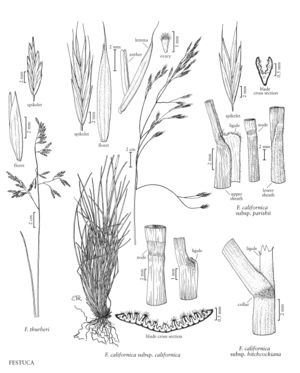Festuca californica subsp. parishii
Culms 30-80(100) cm, densely pubescent for more than 5 mm below the nodes, particularly the upper nodes. Sheaths densely retrorsely pubescent; collars usually densely pubescent, at least at the margins; ligules (0.2)0.5-1.5(2) mm, ciliate; blades 10-30 cm long, 1-3 mm wide, 0.5-1.2(1.5) mm in diameter when conduplicate, abaxial surfaces glabrous or pubescent proximally, adaxial surfaces pubescent, ribs (3)5-9, to about 1/2 as deep as the blade thickness; abaxial sclerenchyma in small strands or forming continuous bands; adaxial sclerenchyma sometimes present; girders not developed; pillars rarely formed. Inflorescences 10-20 cm. Spikelets 11-16 mm, with 3-4(5) florets. Lemmas usually minutely bidentate, sometimes entire. 2n = unknown.
Discussion
Festuca californica subsp. parishii grows in southern California, in the San Bernardino, San Gabriel, and Palomar mountains. Its leaf blades tend to be narrower and shorter than in subsp. californica (10-30 cm long versus more than 30 cm long), and the sclerenchyma is less developed, with pillars only sometimes present and girders absent. The lower leaf sheaths are densely retrorsely pubescent.
Selected References
None.
